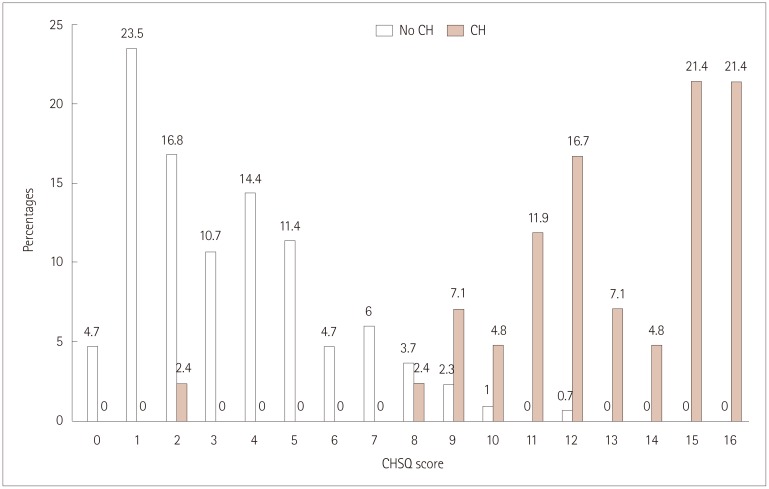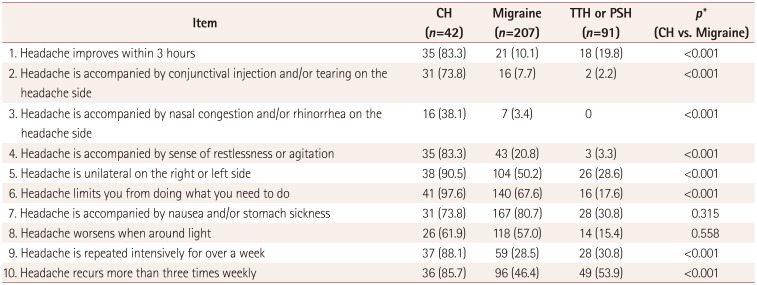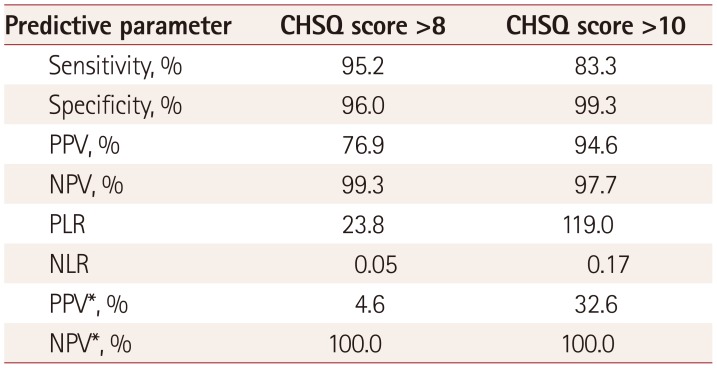1. Goadsby PJ. Pathophysiology of cluster headache: a trigeminal autonomic cephalgia. Lancet Neurol. 2002; 1:251–257. PMID:
12849458.

2. Jensen RM, Lyngberg A, Jensen RH. Burden of cluster headache. Cephalalgia. 2007; 27:535–541. PMID:
17459083.

3. Abu Bakar N, Torkamani M, Tanprawate S, Lambru G, Matharu M, Jahanshahi M. The development and validation of the Cluster Headache Quality of life scale (CHQ). J Headache Pain. 2016; 17:79. PMID:
27596922.

4. Fischera M, Marziniak M, Gralow I, Evers S. The incidence and prevalence of cluster headache: a meta-analysis of population-based studies. Cephalalgia. 2008; 28:614–618. PMID:
18422717.

5. Ekbom K, Svensson DA, Träff H, Waldenlind E. Age at onset and sex ratio in cluster headache: observations over three decades. Cephalalgia. 2002; 22:94–100. PMID:
11972575.

6. Moon HS, Park JW, Lee KS, Chung CS, Kim BK, Kim JM, et al. Clinical features of cluster headache patients in Korea. J Korean Med Sci. 2017; 32:502–506. PMID:
28145655.

7. Gaul C, Finken J, Biermann J, Mostardt S, Diener HC, Müller O, et al. Treatment costs and indirect costs of cluster headache: a health economics analysis. Cephalalgia. 2011; 31:1664–1672. PMID:
21994114.

8. Klapper JA, Klapper A, Voss T. The misdiagnosis of cluster headache: a nonclinic, population-based, internet survey. Headache. 2000; 40:730–735. PMID:
11091291.

9. van Vliet JA, Eekers PJ, Haan J, Ferrari MD. Dutch RUSSH Study Group. Features involved in the diagnostic delay of cluster headache. J Neurol Neurosurg Psychiatry. 2003; 74:1123–1125. PMID:
12876249.

10. Viana M, Tassorelli C, Allena M, Nappi G, Sjaastad O, Antonaci F. Diagnostic and therapeutic errors in trigeminal autonomic cephalalgias and hemicrania continua: a systematic review. J Headache Pain. 2013; 14:14. PMID:
23565739.

11. Robbins MS, Starling AJ, Pringsheim TM, Becker WJ, Schwedt TJ. Treatment of cluster headache: the American Headache Society evidence-based guidelines. Headache. 2016; 56:1093–1106. PMID:
27432623.

12. Leroux E, Valade D, Taifas I, Vicaut E, Chagnon M, Roos C, et al. Suboccipital steroid injections for transitional treatment of patients with more than two cluster headache attacks per day: a randomised, double-blind, placebo-controlled trial. Lancet Neurol. 2011; 10:891–897. PMID:
21903477.

13. Wilbrink LA, Weller CM, Cheung C, Stijnen T, Haan J, Ferrari MD, et al. Stepwise web-based questionnaires for diagnosing cluster headache: LUCA and QATCH. Cephalalgia. 2013; 33:924–931. PMID:
23624341.

14. Dousset V, Laporte A, Legoff M, Traineau MH, Dartigues JF, Brochet B. Validation of a brief self-administered questionnaire for cluster headache screening in a tertiary center. Headache. 2009; 49:64–70. PMID:
19133334.

15. Torelli P, Beghi E, Manzoni GC. Validation of a questionnaire for the detection of cluster headache. Headache. 2005; 45:644–652. PMID:
15953296.

16. Katsarava Z, Obermann M, Yoon MS, Dommes P, Kuznetsova J, Weimar C, et al. Prevalence of cluster headache in a population-based sample in Germany. Cephalalgia. 2007; 27:1014–1019. PMID:
17666085.

17. Headache Classification Committee of the International Headache Society (IHS). The International Classification of Headache Disorders, 3rd edition (beta version). Cephalalgia. 2013; 33:629–808. PMID:
23771276.
18. Preacher KJ, MacCallum RC. Exploratory factor analysis in behavior genetics research: factor recovery with small sample sizes. Behav Genet. 2002; 32:153–161. PMID:
12036113.
19. Lipton RB, Dodick D, Sadovsky R, Kolodner K, Endicott J, Hettiarachchi J, et al. A self-administered screener for migraine in primary care: the ID Migraine validation study. Neurology. 2003; 61:375–382. PMID:
12913201.
20. Youden WJ. Index for rating diagnostic tests. Cancer. 1950; 3:32–35. PMID:
15405679.

21. Lalkhen AG, McCluskey A. Clinical tests: sensitivity and specificity. Contin Educ Anaesth Crit Care Pain. 2008; 8:221–223.

22. McGee S. Simplifying likelihood ratios. J Gen Intern Med. 2002; 17:646–649. PMID:
12213147.

23. Kim BK, Chu MK, Lee TG, Kim JM, Chung CS, Lee KS. Prevalence and impact of migraine and tension-type headache in Korea. J Clin Neurol. 2012; 8:204–211. PMID:
23091530.

24. Lin KH, Wang PJ, Fuh JL, Lu SR, Chung CT, Tsou HK, et al. Cluster headache in the Taiwanese–a clinic-based study. Cephalalgia. 2004; 24:631–638. PMID:
15265051.
25. Voiticovschi-Iosob C, Allena M, De Cillis I, Nappi G, Sjaastad O, Antonaci F. Diagnostic and therapeutic errors in cluster headache: a hospital-based study. J Headache Pain. 2014; 15:56. PMID:
25178541.

26. Barbanti P, Fabbrini G, Pesare M, Vanacore N, Cerbo R. Unilateral cranial autonomic symptoms in migraine. Cephalalgia. 2002; 22:256–259. PMID:
12100086.

27. Barbanti P, Aurilia C, Dall'Armi V, Egeo G, Fofi L, Bonassi S. The phenotype of migraine with unilateral cranial autonomic symptoms documents increased peripheral and central trigeminal sensitization. A case series of 757 patients. Cephalalgia. 2016; 36:1334–1340. PMID:
26858260.

28. Lai TH, Fuh JL, Wang SJ. Cranial autonomic symptoms in migraine: characteristics and comparison with cluster headache. J Neurol Neurosurg Psychiatry. 2009; 80:1116–1119. PMID:
18931007.

29. Obermann M, Yoon MS, Dommes P, Kuznetsova J, Maschke M, Weimar C, et al. Prevalence of trigeminal autonomic symptoms in migraine: a population-based study. Cephalalgia. 2007; 27:504–509. PMID:
17428298.

30. Taga A, Russo M, Manzoni GC, Torelli P. Cluster headache with accompanying migraine-like features: a possible clinical phenotype. Headache. 2017; 57:290–297. PMID:
27861832.

31. Torelli P, Beghi E, Manzoni GC. Cluster headache prevalence in the Italian general population. Neurology. 2005; 64:469–474. PMID:
15699377.

32. Katsarava Z, Dzagnidze A, Kukava M, Mirvelashvili E, Djibuti M, Janelidze M, et al. Prevalence of cluster headache in the Republic of Georgia: results of a population-based study and methodological considerations. Cephalalgia. 2009; 29:949–952. PMID:
19250289.

33. Kim BK, Cho SJ, Kim BS, Sohn JH, Kim SK, Cha MJ, et al. Comprehensive application of the International Classification of Headache Disorders third edition, beta version. J Korean Med Sci. 2016; 31:106–113. PMID:
26770045.

34. de Coo IF, Wilbrink LA, Haan J, Ferrari MD, Terwindt GM. Evaluation of the new ICHD-III beta cluster headache criteria. Cephalalgia. 2016; 36:547–551. PMID:
26395893.










 PDF
PDF ePub
ePub Citation
Citation Print
Print



 XML Download
XML Download